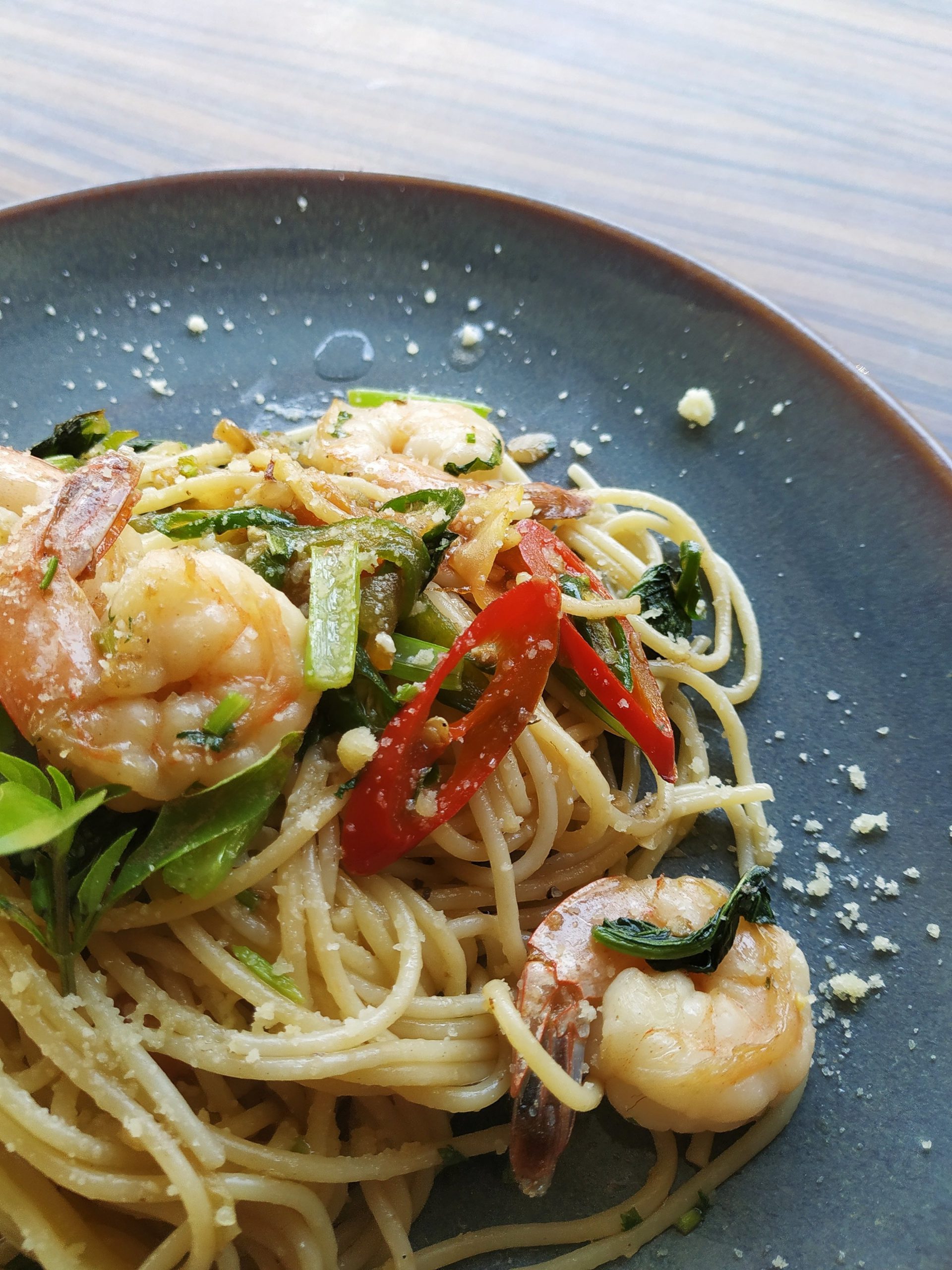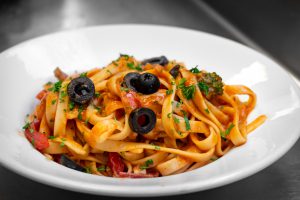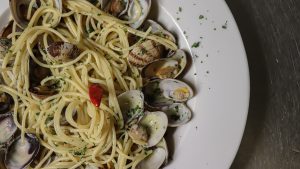
- Readers Rating
- No Rating Yet!
- Your Rating
Do you want to learn 5 Italian sauces for your pasta? Italian cuisine is known worldwide for its rich variety of pastas and sauces that delight palates all over the world. Among the many options it offers, Italian sauces play a vital role in creating authentic and delicious dishes. In this article, we will explore five unique and delicious Italian sauces that transform a simple pasta dish into an unforgettable culinary experience.
1. Arrabiata Sauce: A Touch of Spice
The first of our 5 Italian sauces is the spiciest. Let’s start our gastronomic journey through Italy with Salsa Arrabiata, a bold and flavourful preparation. Arrabiata” in Italian means “angry” or “angry”, which perfectly reflects the spicy character of this sauce. The star component of this delicious sauce is the chilli pepper, which provides the characteristic spiciness.
Salsa Arrabiata is made from tomatoes, garlic, olive oil and, of course, chilli peppers. It is a popular choice for those looking for a pasta dish with a touch of heat. The combination of the acidity of the tomatoes with the spiciness of the chillies creates a perfect balance that adds excitement to any pasta.
Ingredients:
400 g canned peeled tomatoes.
4 cloves garlic, minced
1-2 fresh red chillies, chopped
4 tablespoons olive oil
Salt to taste
Fresh chopped parsley for garnish
Preparation:
- Heat the olive oil in a frying pan over medium heat.
- Add the garlic and chillies and sauté for a few minutes until the garlic is golden.
Add the peeled and crushed tomatoes and season with salt. Cook over medium-low heat for 15-20 minutes, stirring occasionally. - Meanwhile, cook the pasta according to package instructions. Drain and set aside.
- Mix the sauce with the pasta and serve hot. Garnish with chopped fresh parsley.

2. Puttanesca Sauce: Intense Flavours of Southern Italy
Originating from the Campania region, Salsa Puttanesca is a bold and tasty option that combines intense and authentic ingredients. This unique sauce is named “puttana”, which means prostitute in Italian, but its origin is the subject of legend and debate.
The key ingredients of Salsa Puttanesca include tomatoes, garlic, olives, capers and anchovies. These elements combine to create a rich, umami-filled sauce, with the saltiness of the olives and capers complemented by the mildness of the anchovies. Perfect for those looking for bold and complex flavours in their pasta.
Ingredients:
400 g canned peeled tomatoes.
4 tablespoons olive oil
2 cloves garlic, minced
2 teaspoons capers
10 black olives, pitted and chopped
2 anchovy fillets in oil, chopped (optional)
1 teaspoon dried oregano
Red chilli to taste (optional)
Salt and pepper to taste
Chopped fresh parsley for garnish
Preparation:
- Heat the olive oil in a skillet over medium heat. Add the garlic and sauté for one minute.
- Add the capers, olives, anchovies, and chili pepper. Sauté for a few minutes.
- Add the peeled and crushed tomatoes and season with salt, pepper, and oregano. Cook over medium-low heat for 15-20 minutes.
- Mix the sauce with the cooked pasta and serve hot. Sprinkle fresh chopped parsley on top.
3. Sicilian Sauce: A Glimpse into Sicilian Cuisine
Another of our 5 Italian sauces is Sicilian Sauce, a culinary treasure from the vibrant and delicious cuisine of Sicily, the largest island in the Mediterranean. This sauce embodies the authentic Mediterranean flavors and the abundance of local ingredients that characterize the region.
Made with eggplants, fresh tomatoes, olives, capers, and garlic, Sicilian Sauce has a unique combination of flavors. The eggplants provide a smooth and creamy texture, while the olives and capers add a salty touch. It’s a wonderful choice to accompany pasta, bruschettas, or even as a dressing for fish.
Ingredients:
- 2 medium eggplants, cubed
- 400g canned peeled tomatoes
- 4 tablespoons olive oil
- 2 cloves of garlic, chopped
- 2 tablespoons capers
- 10 pitted green olives, chopped
- Salt and pepper to taste F
- resh chopped parsley for garnish
Instructions:
- Place the eggplant cubes in a colander and sprinkle with salt. Let the eggplants sweat for about 30 minutes, then rinse and pat them dry with paper towels.
- Heat 2 tablespoons of olive oil in a skillet over medium heat. Add the eggplants and sauté until they are golden brown. Remove and set aside.
- In the same skillet, add the remaining 2 tablespoons of olive oil and sauté the garlic, capers, and olives. Add the peeled and crushed tomatoes and let them cook for about 15-20 minutes.
- Incorporate the eggplants into the sauce and mix well. Season with salt and pepper to taste.
- Serve the sauce over cooked pasta and sprinkle with fresh chopped parsley before serving.
-
Cacciatore Sauce: The Taste of Hunt in Your Pasta
Cacciatore Sauce, which in Italian means hunter, evokes the essence of Italian hunting traditions. This recipe is another of our 5 rustic and comforting Italian sauces that brings to mind hunter’s meals after a day in the field.
Cacciatore Sauce is prepared with tomatoes, onions, peppers, mushrooms, and often includes olives and capers. The combination of these ingredients creates a hearty and flavorful sauce, perfect for accompanying meats like chicken, rabbit, or pork. Cacciatore sauce adds an Italian touch to your pasta dish or your favorite meat.
Ingredients:
- 4 chicken breasts
- Salt and pepper to taste
- 1/2 cup all-purpose flour
- 4 tablespoons olive oil
- 1 onion, chopped
- 1 red bell pepper, sliced
- 1 green bell pepper, sliced
- 2 cloves of garlic, chopped
- 200g mushrooms, sliced
- 400g canned peeled tomatoes, crushed
- 1/2 cup chicken broth
- 1/2 cup white wine
- 2 teaspoons dried oregano
- 2 teaspoons dried basil
- Salt and pepper to taste
- Fresh chopped parsley for garnish
Preparation:
- Season the chicken breasts with salt and pepper and coat them in flour, shaking off the excess.
- Heat 2 tablespoons of olive oil in a large skillet over medium-high heat. Add the chicken breasts and cook until they are golden brown on both sides. Remove the chicken and set aside.
- In the same skillet, add the remaining 2 tablespoons of olive oil and sauté the onion, peppers, and garlic until they are tender.
- Add the mushrooms and cook for a few minutes until they are tender.
- Pour in the white wine and let it reduce by half. Then, add the crushed tomatoes, chicken broth, oregano, basil, salt, and pepper. Stir well.
- Return the chicken breasts to the skillet and cook over medium-low heat for about 20-25 minutes or until the chicken is cooked through, and the sauce has thickened.
- Serve the cacciatore sauce over cooked pasta and sprinkle with fresh chopped parsley before serving.

5. Vongole Sauce: Seafood Flavors on Your Plate
The last of our 5 Italian sauces. We conclude our culinary journey with Vongole Sauce, which takes us straight to the Italian coasts. “Vongole” in Italian means clams, and this sauce highlights the delicious combination of sea flavors.
Vongole Sauce is prepared with clams, garlic, olive oil, parsley, and often a touch of dry white wine. The simplicity of the ingredients allows the natural flavor of the clams to shine through. It’s a wonderful choice for seafood lovers and adds a unique dimension to any pasta dish.
Ingredients:
- 400g pasta (spaghetti, linguini, or spaghetti)
- 500g fresh clams
- 4 tablespoons olive oil
- 4 cloves of garlic, chopped
- 1 red chili pepper, chopped (optional)
- 1/2 cup dry white wine
- Fresh chopped parsley
- Salt and pepper to taste
Preparation:
- Rinse the clams thoroughly under cold water.
- Cook the pasta according to the package instructions in salted water until al dente.
- Meanwhile, in a large skillet, heat the olive oil over medium heat. Add the garlic and chili pepper and sauté for one minute.
- Add the clams to the skillet and pour in the white wine. Cover and cook until the clams open, approximately 5-7 minutes.
- Drain the pasta and add it to the skillet with the clams and cooking juices. Toss well to allow the pasta to absorb the flavors.
- Serve the pasta with clams in individual plates and sprinkle with fresh chopped parsley.
Don’t miss our culinary curiosities on the Mentta blog!
